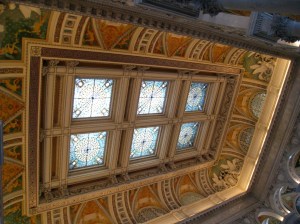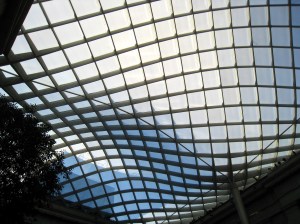Happy March Madness! It’s true, I barely know what that is. But the DC chapter of Emerging Museum Professionals created an alternative, Museum Madness, which involves visiting eight museum exhibits, filling out a bracket, and voting on our favorites.
My favorite exhibit of the eight is Birds of Paradise at the National Geographic Museum. I realized from this exhibit that male birds hoping to mate are hilarious! The exhibit includes “dance cards” that describe in detail the dance moves that male birds perform, first-of-its-kind video footage of male birds from the vantage point of female birds perched on a branch above, and a DDR-style video game called Dance Dance Evolution. As amusing as the birds (and humans trying to imitate their dance moves) are, the exhibit is really a highly interactive exploration of the behaviors and physical traits (beautiful plumage) that birds in New Guinea have evolved through natural selection. There are actual bird specimens on display, along with sections devoted to the role that birds of paradise play in local human cultures, the history of scientific study of birds, and, since it’s National Geographic, some beautiful photography.
Competing with Birds of Paradise in the Zoology category is the Bird House at the National Zoo. This exhibit has the advantage of having living breathing birds, but on the day I visited, the Indoor Flight Exhibit was closed. I did thoroughly enjoy a nearby exhibit, the Outdoor Flight Exhibit, in which the visitor is immersed in a large space where various birds are free to fly, swim, and otherwise roam around.
Another exhibit I loved was Exploring the Early Americas at the Library of Congress, which is in a bracket against 50 Years of Pre-Columbian Art at Dumbarton Oaks. I liked both exhibits, and indeed, the objects are largely similar across the two. The LOC’s exhibit got extra points from me for its combination of documents and functional objects, its technological features, and its section on the issue of human rights for people in the New World after European conquest. This last point tipped the LOC exhibit that much more toward being cast as a history exhibit (as any exhibit of human history should be) rather than a natural history exhibit. And though it may be a small detail, the method of numbering and labeling objects at the LOC makes it easier to determine which description corresponds to which object, in comparison to the labels at Dumbarton Oaks. One thing I liked better about 50 Years is that photography is permitted.
At Dumbarton Oaks, I was most enthralled by a separate exhibit, All Sides Considered, which looks at six ancient Mayan objects or sets of objects in detail. Text and tech features show visitors six ways that researchers learn about objects, from materials and techniques to function and significance.
I was a fan of both art exhibits in the bracket: Faking It at the National Gallery of Art and Drawing on the Edge at the National Portrait Gallery. Faking It won this round for me, because the subject is so interesting, and the exhibit so thorough. How often do we get to see art exhibits that highlight artists’ foibles or stretching of the truth? The exhibit shows pre-Photoshop manipulations of photography, for purposes ranging from artistic touch-ups, to photos with a certain sense of humor (a row of people all holding their severed heads; a man in a bottle), to disturbing distortions of history. One series of Soviet photos is just as they say in history class: it is the same photo, but in the first instance it has five people; in successive photos, they are cropped out one by one.
Drawing on the Edge shows portraits by six contemporary artists. I especially enjoyed the graphite drawings by Rob Matthews, which show subjects sitting with an object that has meaning to them. Of course, as a museum person, I am interested in objects and how people relate to them. (Plus, look at the kitty!)
The final set of exhibits relates to women’s history, and I wrote a little about them in another recent blog post. First Ladies is an exhibit I’ve seen before; it draws lots of visitors and was rather crowded. Sure, the dresses and dishes are pretty, but this exhibit has never been my favorite thing in the National Museum of American History, where I’ve seen such compelling, cerebral presentations as The Price of Freedom, the Greensboro lunch counter, and Thomas Jefferson’s Bible. The competing online exhibit, First But Not the Last on the National Museum of Women’s History’s website, was interesting, but as a mostly-text exhibit, it pales in comparison to seeing a display in a brick-and-mortar museum.
Are there any fellow Museum Madness participants reading this? Which exhibits did you like best?
*
March’s blog theme is Museums and Fighting Inequality.






